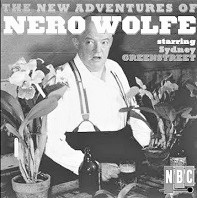
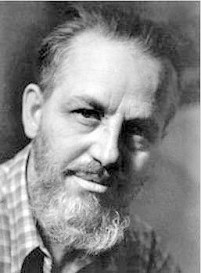 The New Adventures of Nero Wolfe (1950-51) aired “The Slaughtered Santas” on December 22, 1950 as the 10th of the 26 episodes of this run. Prior to this radio reincarnation there were two earlier series, one in 1943 and another in 1945 (each short-lived), and relatively little is known about them with only two episodes now known to be in circulation. Thus, along with the 26 episodes of this 1950-51 series only 28 episodes survive. This is only the fourth Nero Wolfe episode we have showcased, the first two being in April and September of 2018 and the third being from June of 2019. For newcomers to the series we reprise the introductory material offered in that first episode.
The New Adventures of Nero Wolfe (1950-51) aired “The Slaughtered Santas” on December 22, 1950 as the 10th of the 26 episodes of this run. Prior to this radio reincarnation there were two earlier series, one in 1943 and another in 1945 (each short-lived), and relatively little is known about them with only two episodes now known to be in circulation. Thus, along with the 26 episodes of this 1950-51 series only 28 episodes survive. This is only the fourth Nero Wolfe episode we have showcased, the first two being in April and September of 2018 and the third being from June of 2019. For newcomers to the series we reprise the introductory material offered in that first episode.
The Nero Wolfe radio programs were of course based on the popular mystery/detective novels of Rex Stout (1886-1975, photo at right). From the first Nero Wolfe novel in 1934 (Fer-de-Lance), Stout would write a total of 33 Wolfe novels and 39 novellas. Wolfe was given to us as a large man, described as being 5’11” and weighing “a seventh of a ton” (which is about 286 lbs.). Wolfe is an eccentric character in several respects. Due to his size he rarely leaves his home, avoids physical contact with both women and men, is fed gourmet meals served by his talented Swiss chef, reads voluminously, does not own a television, spends an inordinate amount of time tending his orchids, and apparently enters some kind of trance state when mentally solving crimes. This last is perhaps a reflection of the method by which Stout wrote the novels, for he has gone on record as saying he wrote them complete in his head before setting them to paper, and never reread them once finished. Rarely venturing outside the confines of his home, Wolfe relies on his able assistant Archie Goodwin to do the legwork–chasing down leads and clues and interviewing persons of interest. Verbal wordplay between Wolfe and Goodwin shows them at times to be at odds with one another, the amicable jibes springing from their contrasting personalities lending added spice to the stories.
In 1958 Stout became the MWA’s 14th President, and in 1959 he was honored as the Mystery Writers of America’s third ever Grand Master, its highest award. At Bouchercon XXXI in 2000, the Nero Wolfe novels were nominated as Best Mystery Series of the Century, and Stout was nominated as Best Mystery Writer of the Century.

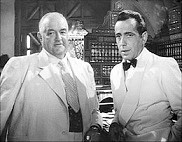 The New Adventures of Nero Wolfe starred the incomparable Sydney Greenstreet (1879-1954, photo top left and elsewhere) as Rex Stout’s iconic detective. Greenstreet is best known and remembered for his film roles, the first of which (at age 62) was as Kaspar Gutman (“The Fat Man”) in 1941’s The Maltese Falcon, opposite Humphrey Bogart as detective Sam Spade (photo at left). It was Gutman who had spent many years traveling the world and a sizeable fortune in search of the jewel-encrusted bird that was the McGuffin driving the plot in this now classic movie. His fourth film a year later in 1942 saw him in a secondary role in yet another of Hollywood’s classic films, Casablanca (photo at right), as Signor Ferrari, owner of the Blue Parrot, a rival establishment to Bogart’s character Rick Blaine and his Cafe Americain. Once again, Greenstreet was cast as an unsavory character, exemplified by Ferrari’s ironic statement: “As leader of all illegal activities in Casablanca, I am an influential and respected man.” Though beginning his film career at a late age, Sydney Greenstreet would have various roles in 24 films from 1941 through 1949, an average of three films a year. During this time he would share screen time with some of the biggest stars in Hollywood, including Spencer Tracy, James Stewart, Humphrey Bogart, Clark Gable, Ava Gardner, and Joan Crawford. Tennessee Williams wrote his play The Last of My Solid Gold Watches with Greenstreet in mind, dedicating it to him. It was at the end of his brief, eight-year film career in 1949 that Greenstreet took on the role of Nero Wolfe for radio. Stout is reported to have been highly pleased with Greenstreet in the role of his genius detective, and while a popular show it left the airwaves after 26 episodes, the advent of the new medium of television convincing potential sponsors to divert their advertising dollars to tv with its potentially larger national audience reach.
The New Adventures of Nero Wolfe starred the incomparable Sydney Greenstreet (1879-1954, photo top left and elsewhere) as Rex Stout’s iconic detective. Greenstreet is best known and remembered for his film roles, the first of which (at age 62) was as Kaspar Gutman (“The Fat Man”) in 1941’s The Maltese Falcon, opposite Humphrey Bogart as detective Sam Spade (photo at left). It was Gutman who had spent many years traveling the world and a sizeable fortune in search of the jewel-encrusted bird that was the McGuffin driving the plot in this now classic movie. His fourth film a year later in 1942 saw him in a secondary role in yet another of Hollywood’s classic films, Casablanca (photo at right), as Signor Ferrari, owner of the Blue Parrot, a rival establishment to Bogart’s character Rick Blaine and his Cafe Americain. Once again, Greenstreet was cast as an unsavory character, exemplified by Ferrari’s ironic statement: “As leader of all illegal activities in Casablanca, I am an influential and respected man.” Though beginning his film career at a late age, Sydney Greenstreet would have various roles in 24 films from 1941 through 1949, an average of three films a year. During this time he would share screen time with some of the biggest stars in Hollywood, including Spencer Tracy, James Stewart, Humphrey Bogart, Clark Gable, Ava Gardner, and Joan Crawford. Tennessee Williams wrote his play The Last of My Solid Gold Watches with Greenstreet in mind, dedicating it to him. It was at the end of his brief, eight-year film career in 1949 that Greenstreet took on the role of Nero Wolfe for radio. Stout is reported to have been highly pleased with Greenstreet in the role of his genius detective, and while a popular show it left the airwaves after 26 episodes, the advent of the new medium of television convincing potential sponsors to divert their advertising dollars to tv with its potentially larger national audience reach.
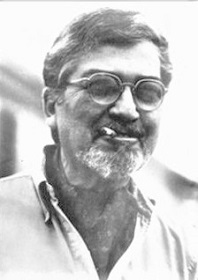 Of interest to SF fans is that none other than SFWA Grand Master Alfred Bester (1913-1987) wrote nearly all 26 episodes of the 1950-51 era Nero Wolfe reboot. Bester also penned scripts for other radio shows during the 1940s, among them Nick Carter–Master Detective, The Shadow, and Charlie Chan, several episodes of the first two we have presented here over the years. Those interested in timelines will note that The New Adventures of Nero Wolfe aired its final episode in late April of 1951. Alfred Bester’s classic, award-winning novel The Demolished Man began its three-part serialization in Galaxy magazine approximately eight months later, in January of 1952, winning the first-ever Science Fiction Achievement Award in 1953 (retroactively named the “Hugo” in 1955) following its book appearance in 1952. How long had Bester been working on this novel? Was it in the works while he was writing episodes of Nero Wolfe? Was it written after the radio show ended, and in a relatively short period of time? Given lead times for magazines to shepherd a typewritten story through the editing and production process to finished product and to appear on the newsstand or in a bookstore, the novel could possibly have been written and fast-tracked by editor Horace Gold during the eight months between the demise of Nero Wolfe, if indeed it was begun after the show ended. It’s interesting to speculate on such rather peripheral matters, so in the spirit of these things I would guess the novel was in the works before the Nero Wolfe series came to its end. In either case, Bester was a busy man at the time writing for two mediums, each with distinct requirements and not something every writer could do, and do well.
Of interest to SF fans is that none other than SFWA Grand Master Alfred Bester (1913-1987) wrote nearly all 26 episodes of the 1950-51 era Nero Wolfe reboot. Bester also penned scripts for other radio shows during the 1940s, among them Nick Carter–Master Detective, The Shadow, and Charlie Chan, several episodes of the first two we have presented here over the years. Those interested in timelines will note that The New Adventures of Nero Wolfe aired its final episode in late April of 1951. Alfred Bester’s classic, award-winning novel The Demolished Man began its three-part serialization in Galaxy magazine approximately eight months later, in January of 1952, winning the first-ever Science Fiction Achievement Award in 1953 (retroactively named the “Hugo” in 1955) following its book appearance in 1952. How long had Bester been working on this novel? Was it in the works while he was writing episodes of Nero Wolfe? Was it written after the radio show ended, and in a relatively short period of time? Given lead times for magazines to shepherd a typewritten story through the editing and production process to finished product and to appear on the newsstand or in a bookstore, the novel could possibly have been written and fast-tracked by editor Horace Gold during the eight months between the demise of Nero Wolfe, if indeed it was begun after the show ended. It’s interesting to speculate on such rather peripheral matters, so in the spirit of these things I would guess the novel was in the works before the Nero Wolfe series came to its end. In either case, Bester was a busy man at the time writing for two mediums, each with distinct requirements and not something every writer could do, and do well.
As for “The Slaughtered Santas” there’s not much to say, except that for Christmas traditionalists who love their sugar and spice this episode will prove as a reminder that not only sugar plum fairies walk the Earth. (Well, yes, fairies mostly fly and don’t walk, but they have to land some time.) And for those who are tired of the holidays in general and revel in their bah-humbugness, this story should fill them with glee.
Play Time: 28:45
{With Christmas but three days away when “The Slaughtered Santas” aired, and with some early Christmas money from grandparents burning a hole in their pockets, the neighborhood gang headed for their favorite haunt, the corner newsstand. Listening to Boston Blackie got them in the mood for more detective adventures and the magazines below had just what they were looking for. 15 Story Detective (1949-51) would last coincidentally but 15 issues, but did feature a number of stories from John D. MacDonald. It was a bi-monthly during the entirety of its brief run. New Detective (1941-55) ran solid, page-turning material, maintaining its faithful readership through the paper shortages during the war years and then through the pulp magazine crash of the early 1950s. It was a bi-monthly in 1950. Thrilling Detective (1931-53) was one of the detective pulps with the longest newsstand presence of any in the history of the genre, having found a formula in touch with the pulse of its changing readership over the decades, and that could then reflect those changes in its fiction, not always an easy task. It too was a bi-monthly in 1950.]
[Left: 15 Story Detective, Dec. 1950 – Center: New Detective, Nov. 1950 – Right: Thrilling Detective, Dec. 1950]
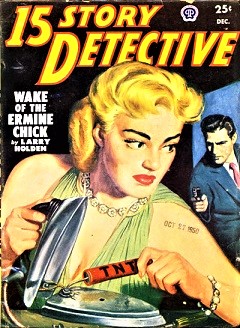
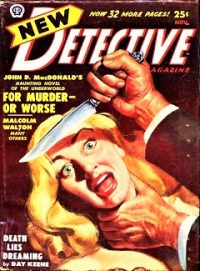

To view the entire list of weekly Old Time Radio episodes at Tangent Online, click here.